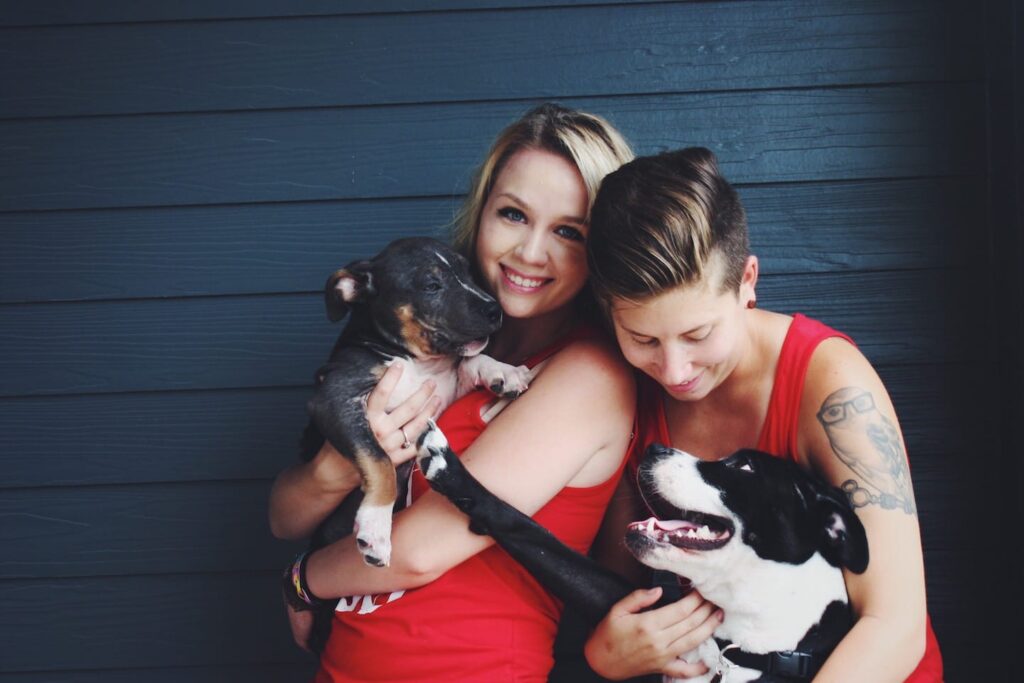Fostering Versus Adoption: Should I Foster or Adopt a Pet?

Unlike swinging by a petstore and picking up a goldfish, the choice to foster or adopt a cat or dog is a greater commitment. These animals require more physical care, such as walks and grooming. They also require play and cuddle time for emotional bonding. So should you get a cat or a dog? And should you foster or adopt a pet? Here is the ultimate guide to fostering versus adoption!
Cats Versus Dogs
Sometimes people know in their gut whether they’re a “cat person” or a “dog person.” Some folks just love the picky nature of a cat or the joie de vivre of a dog. However, the choice isn’t so simple for other people. And, of course, some people love both types of pets! Cats and dogs alike make amazing family members, but they are very different creatures.
Cats
Cats are on the smaller side, averaging roughly 10 lbs in weight. They are highly self-sufficient compared to dogs and usually don’t need as much attention. Most cats use a litter box and groom themselves. While some don’t enjoy human attention very much, other cats can be very affectionate and enjoy cuddle time on the couch. More often than not, cats have a mind of their own. They’re more difficult to train and they make up their own rules. While you don’t have to worry about daily walks, cats can also come with hairballs and scratched furniture.
Dogs
Dogs are smart creatures who range from the size of your palm to the size of a pony. Dogs generally require a bit more upkeep and attention than cats, including daily walks and socialization. Pooches are loyal animals and want nothing more than to spend their day with you. Dogs are more easily trainable and are more likely to enjoy spending time with you outside the home. If you want a pal to join you on car rides, trips to the park and Sunday brunch, a dog might be the right pet for you.
Which Should You Choose?
Your history with dogs or cats can greatly influence which breed you prefer. Maybe you had a bad run-in with a cat’s claws or were chased down by an unruly pooch as a child. Some people are also born with a dog or cat phobia. When some people see a goofy grin, another person might see vicious fangs. Obviously allergies should also be taken into account. A bad case of dog allergies or cat allergies can ruin the pet adoption or fostering experience.
The best way to decide on if you want to bring a dog or cat into your home is to spend time with each type of animal. Visit friends who have pets or, even better, volunteer at an animal shelter. It’s a best way to get a feel for what it’s like to spend lots of time with each species. Volunteering also gives you an idea of how high-maintenance each type of animal is. Lastly, you’ll also learn just how different one animal is from another. Some dogs are high-energy jackrabbits, while others are total couch potatoes. And some cats are aloof wall flowers while others are excellent snuggle buddies.
How to Foster a Cat
Fostering a cat is quite different from fostering dogs. In general, there’s a greater need for kitten fosters than foster parents for grown cats. Our Adopt & Shop stores in Southern California always need cat fosters, so we encourage you to apply.
Fostering a cat is a smaller overall commitment than adopting a cat. It’s a smaller time commitment, and will generally last only 2-8 weeks. And many shelters like Adopt & Shop provide the supplies and vet care, so it’s a smaller financial commitment as well. It can also be a good way to try your hand at pet ownership, before committing to an actual adoption. Here are the different types of cats that need fosters.
“Regular” Kittens
Kitten foster parents generally care for several siblings instead of a single cat. Regular kittens are much lower maintenance than bottle babies, however. They don’t need to be fed several times a day, so you can work a regular job outside of your home and sleep through the night.
Being a kitten foster doesn’t require much room or much of your time. Kittens do well in a small space, so even just a corner of your bathroom will suffice. Your main duties will be feeding them and playing with them for a few hours each day. Playtime socializes the kittens, resulting in an adult cat that is comfortable being around other felines and humans. These couple of hours are all it takes to make sure the kittens grow up happy and healthy. You’ll hold on to the kittens until they each weigh 2 lbs. Then they’re big enough to be spayed and neutered and adopted out to their forever homes!
To foster kittens, you need:
- Cage or other sort of enclosure. Kittens get overwhelmed and are harder to litter train in large spaces.
- Small room. Again, kittens do best in small spaces. Many foster parents keep their kitten crates in the bathroom because it’s easier to clean in there.
- Puppy pads. Yes, puppy pads. Kittens aren’t very clean creatures, so putting puppy pads under litter boxes and bowls makes cleanup a little easier.
- Humidifier and heating pad. Kittens get cold easily and benefit from warm moist air.
- Cat tree or other furniture and toys. These items keep your kittens from getting bored.
Bottle Baby Kittens
Do you have what it takes to join the Itty Bitty Kitty Committee? Bottle baby kittens are too young to eat solid food yet so they need to be fed with a bottle. They are a little higher maintenance than older kittens. They need to be fed at least every four hours, much like a human infant. So if you need your beauty sleep or don’t work from home, bottle babies might not be for you.
Bottle baby foster parents also need to do daily check-ins, keeping a close eye on each kitten’s weight and health. But while bottle babies are hard work, they are cute as can be, fitting in the palm of your hand! You’ll likely receive a litter to take care of, instead of a single kitten.
Here are some essentials that you’ll need for bottle babies:
- Gram scale and weight chart. These help you in making sure they’re gaining the weight necessary to be healthy.
- Soft wipes for “stimulating.” Unlike older cats, you’ll need to teach these babies how to go to the bathroom.
- Nursing bottle, miracle nipple and milk replacer. These items are necessary for ensuring the kittens are getting the right nutrients.
- Gruel supplies. You’ll feed the kittens gruel to transition them from the milk replacer to regular, solid cat food.
Adult Cats
The last type of feline you can foster is an adult cat. Adult cats are more likely to be passed over in a shelter, which is a crying shame because they are such terrific pets. So volunteering to foster an adult cat is a wonderful service. While tons of cats do beautifully in a shelter environment, some kitties struggle with the many sights and sounds. It can be a hectic place to live and they may do better in a quiet home.
Unlike fostering kittens, you only need to take on one adult cat at a time. The extent of your responsibilities will be feeding the feline and giving them a roof over their head. Adult cats are also likely to already be litter-trained so you won’t have to teach them where to use the bathroom.
How to Foster a Dog
Fostering an adult dog generally isn’t quite as tricky as fostering bottle baby kittens, but it is more involved than fostering an adult cat. First off, you’ll have to make sure that the dog is properly groomed. This involves brushing the dog’s teeth daily and regularly brushing their coat. Some dogs shed quite a bit, so they might also result in more cleaning around the house.
Fostering dogs also sometimes requires a lot of behavior training. Cats generally figure out how to use a litter box on their own, but dogs need to be taken outside to be housetrained. Puppies sometimes need to be taken outside throughout the night to avoid soiling your house. Then you need to socialize the dog by spending lots of time with them and taking them on daily walks. This allows the dog to grow accustomed to other pups and humans.
How to Adopt a Dog or Cat
While there are many differences between dogs and cats, the adoption process for both animals is fairly similar. Owning each type of pet is very different, but where you look for the right fuzzy family member and which traits you consider before adopting a pet are the same. Here are the different things to think about before adopting a dog or cat.
Age
There are few things more joyous than spending time with a puppy or kitten. But we also gotta say that there are few things more exhausting. Puppies and kittens are HARD WORK. Puppies likely aren’t housetrained and will pee and poop everywhere. You need to take them outside throughout the night to make sure they end up properly housetrained. They also will probably chew up everything you own and jump all over people and furniture. Kittens might scratch up all your furniture or roll around in their food bowls.
Teenaged dogs and cats are a little easier to care for. While they are more likely to be housetrained, they might still be learning some manners. Teenagers can also be headstrong and have the same never-ending energy of a puppy or kitten.
Adult dogs and cats are generally housetrained and the dogs might even know basic commands like “sit” and “stay.” They’re less hyper than younger animals and probably have better manners. Most of all: They’re available everywhere. Go to any shelter and there will be plenty of wonderful adult pets looking for a loving family.
If an adult pet wasn’t raised right, they might have some hang-ups that you’ll have to work through when adopted. Some of these neuroses include a fear of stairs or bicycles. Or maybe they’re more comfortable around women than men. Many of these problems are solved with some training and settling into their forever home. Lots of positive reinforcement fixes most behavioral issues. And don’t believe the stigma that shelter pets are damaged goods. They make just as good pets as animals purchased from a breeder!
Senior dogs and cats are frequently overlooked because, well, they’re old. People are afraid to get too attached to a dog that doesn’t have as many years left to live. But we love senior dogs and cats. These retired angels are usually sweet, well behaved and totally grateful for love and a warm bed. Senior dogs frequently don’t require a lot of training and only need a short walk each day.
Energy Level
You might already know what energy level in a pet is best for your family. If you don’t, consider your current lifestyle. If you’re a runner or hiking enthusiast, you might do well with a high-energy pet. And couch potatoes will probably want a low-energy pet.
Size
What is your living situation? Generally apartment-dwellers do best with a small dog or cat. Many landlords have pet weight restrictions for their tenants. Also, usually bigger dogs need more indoor space and also benefit from a backyard.
Personality
Finding a dog or cat with the right personality, not breed, is key to a happy pet adoption. Wall flowers might seek out shy pets or gregarious people might want to adopt a social butterfly. Then again, sometimes opposites attract. For instance, introverts sometimes find that an outgoing pet helps them get out of the house more and make friends.
Keep in mind that a lot of animals might seem shy at first but quickly warm up to people. Speak to the team at the shelter and ask them about the pet. Are they independent or do they stick to people like glue? Are they playful or do they just want to nap and cuddle?
You also need to consider your living arrangement. Does your future pet need to be dog-friendly or cat-friendly? Do they need to be comfortable around a lot of people or children? Is your house full of hustle and bustle or calm and quiet?
The easiest way to figure out if a pet has the right personality for you is to spend time with them. Go to the shelter in person and arrange some one-on-one time to see if the two of you click. You might also want to meet with several pets. If you don’t feel it in your gut that a pet is “the one,” then don’t adopt them. There are plenty more cats and dogs available and eventually you’ll find your four-legged soulmate!
Where to Adopt a Pet
There are two ways to find a pet: Maybe you know what you want, and look specifically for that animal. The other option is that you aren’t sure which kind of animal is best for your family, so you visit a shelter or rescue and browse. Both of these options are a-okay!
Regardless of which way you go about the search process, you might want to try browsing pets online first. Great sites like Adopt-A-Pet and Petfinder allow you to search for animals by age, size, zip code and more. These websites are a terrific option if you wish to add a specific breed to your family, but want to adopt a homeless animal in need instead of buying from a breeder. That being said, we here at Michelson Found Animals are very pro-mutt. These unique fur-babies are a joy to add to your family.
You can also simply visit a nearby shelter or rescue and take a look around. Speak to the adoption counselors on site about the various animals. They can tell you more about the pets’ personality and what kind of care they will require. If you have your heart set on a specific breed, look at rescues in your area. Many rescues devote themselves to only a specific type of dog or cat. This way you can get the specific pet of your dreams, but still save a life!


